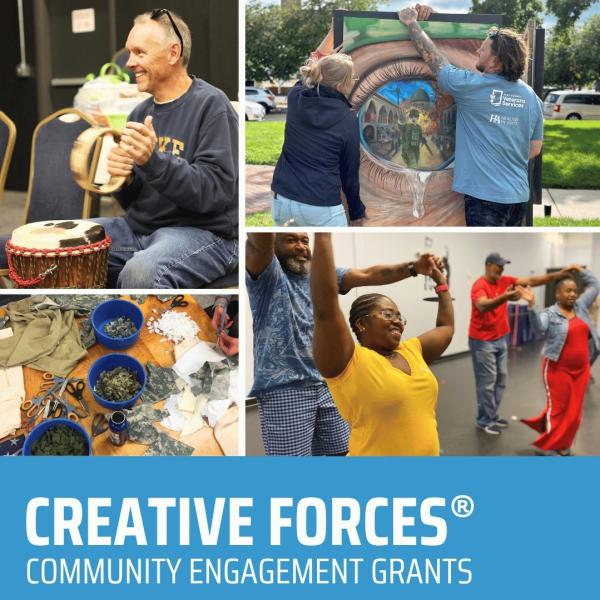New Look at the NEA's Survey of Public Participation in the Arts Data Reveals that 3 out of 4 Americans Participate in the Arts
For nearly three decades, the periodic survey has focused primarily on live attendance at "benchmark" arts activities which are defined as live attendance at jazz or classical music concerts, opera, plays, ballet, or visits to art museums or galleries. Although attendance rates have declined or held flat for these activities, this depiction of arts participation habits is incomplete. Going forward, the NEA will measure and analyze a fuller spectrum of artistic genres, arts participation via electronic media, and personal arts creation.
To launch this expanded conversation, the NEA invited Nick Rabkin and E.C. Hedberg of NORC, University of Chicago; Mark J. Stern of the University of Pennsylvania; and Jennifer L. Novak-Leonard and Alan S. Brown of the research firm WolfBrown to mine the SPPA data. Their findings are offered in three, newly released reports that also confirm the importance of arts education, argue for a more expansive system to measure arts participation, and challenge the notion of the "graying" of arts audiences.
"We are encouraging researchers to ask new questions about how Americans engage with the arts, and the new analysis can help arts organizations reach audiences through new venues, new delivery systems, and new approaches." said NEA Chairman Rocco Landesman. "While this research is encouraging, it also confirms that arts education as a child is an important factor in arts participation as an adult. Arts education is a key way to promote more arts participation."
Among the key findings:
Using a definition that more accurately reflects Americans' arts participation, the 2008 SPPA data reveals that 3 out of 4 Americans participate in arts activities. This definition includes a fuller variety of artistic genres, participation via electronic media, and personal arts creation.
- The 2008 SPPA data show that nearly 75 percent of adults attended arts activities, created art, or engaged with art via electronic media. This is more than twice the share of adults (34.6 percent) who attended "benchmark" arts events such jazz or classical music concerts, opera, plays, ballet, or who visited art museums or galleries.
- The highest rates of participation via electronic media--including mobile devices and the Internet--were reported for classical music (18 percent), Latin music (15 percent), and programs about the visual and literary arts (15 percent each).
- In 2008, 24 percent of U.S. adults attended a music, theater, or dance performance at a school, and 19 percent attended such a performance at a religious institution. These percentages are among the highest rates of attendance for any arts activity captured by the 2008 SPPA.
- There are ample opportunities for audience engagement through electronic media, non-traditional venues, and new program formats.
- Nearly one-third of all American adults (30 percent or 67 million) both attended and created or performed art in the 2008 survey (down from 42 percent in 1992). The percentage of adults who only attend or only create art has remained relatively stable across survey years.
- An American adult who creates or performs art is more than twice as likely to attend arts events than one who does not create or perform art. (i)
- There is a strong link between creating and attending art. Adults who attended a dance performance reported the overall highest rate of creative participation (80 percent) in any artistic discipline. Eighty-one percent of people who engaged in creative writing also read literature, and 60 percent of Americans who created visual art or acted in a play also attended an art museum or gallery, or a theater performance, respectively.
- In addition to reporting higher arts-attendance rates, those who receive arts education as a child are more likely to create or perform art, engage with the arts via media, and take art classes as an adult.
- In 1982, nearly two-thirds of 18-year-olds reported taking art classes in their childhood. By 2008, that share had dropped below one-half (2.2 million (ii)), a decline of 23 percent.
- Declines in childhood arts education from 1982 to 2008 are much higher among African American and Hispanic children than among white children. In that timeframe, there was a 49 percent drop for African Americans, and a 40 percent drop for Hispanic children, compared with a statistically insignificant decline for white children.
- There are patterns related to age and generation that are significant. For example, older adults (born in 1955 or earlier) are more likely than younger Americans to be "cultural omnivores," people who attend a variety of arts events, in different art forms and settings. As these generations have aged, there have been fewer cultural omnivores; furthermore, they are now attending arts events less frequently. It is estimated that 82 percent of the decline in total benchmark arts activities attended between 2002 and 2008 stems from this combination.
- Since the 1970s, broad changes in personal life have influenced arts and civic participation. Although the "cultural omnivore" model may be declining, a more personal, flexible approach to cultural engagement is a growing trend.
- Age and generation may be less important in audience outreach than previously thought.
Contact
Sally Gifford
202-682-5606
giffords@arts.gov




